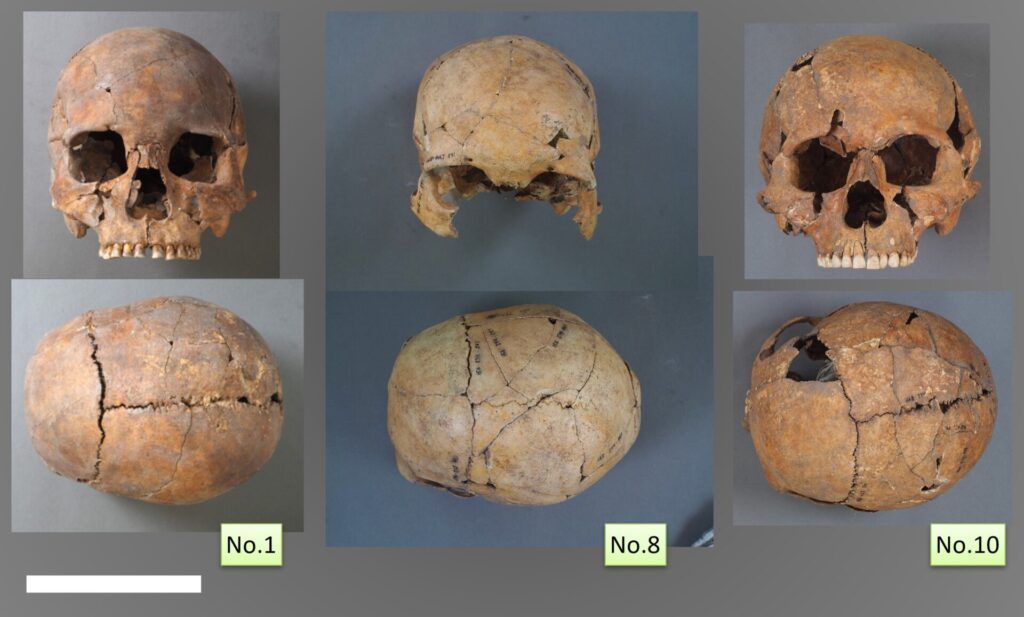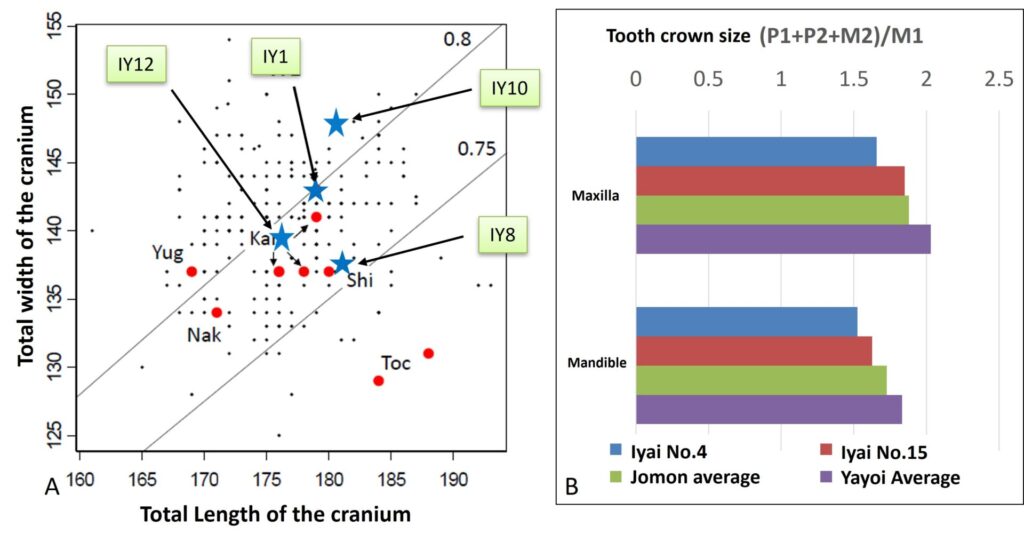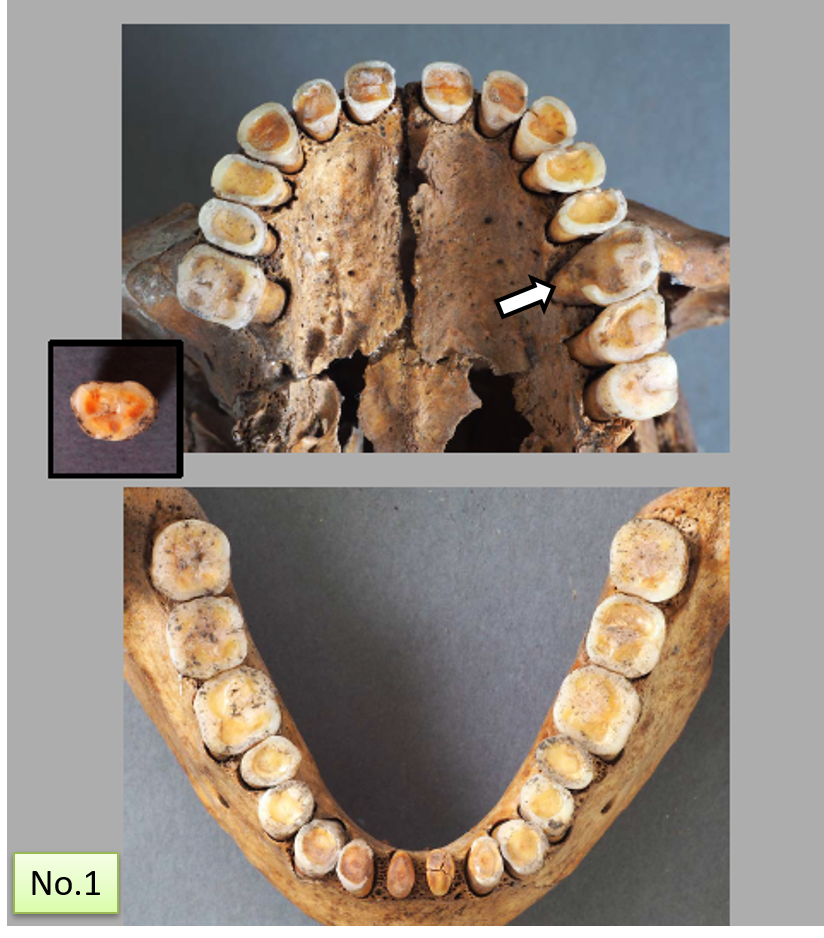Morphological Anthropology
A substantial number of human skeletal remains dating from the Initial Jomon to Early Jomon periods have been unearthed from the Iyai rock-shelter site. These discoveries encompass individual burials as well as multiple burials comprising two or more individuals. This section explores the physical traits status of six individual burials that have been sorted and reconstructed so far. All six date to the Initial Jomon period.
Table 1 summarizes the estimated sex and age at death, dental wear, dental caries, and other health indicators of the six individuals. No. 4 and No. 15 are subadults (around the age of puberty), making it difficult to determine their sex from their skeletal morphology. The other four individuals are all female and are considered to have died at a relatively young age (around 20 to 30 years of age). Thus far, the majority of the individuals buried at the site are those of females who were young at the time of their death. While there is a notable number of females, it’s likely coincidental, as males have also been identified among the large number of individuals currently being sorted out. However, previous studies have suggested a tendency for early mortality during the Initial Jomon period. Further analysis of the Iyai human skeletal remains will be of significant interest in the future to explore this aspect further.
| Sex | Age | Occlusal wear | Caries | Health Indicators | Other | |
|---|---|---|---|---|---|---|
| No.1 | Female | Young adult | Severe | Present | ||
| No.4 | ? | Subadult (15±3yr) | Slight | LEH/Calculus | ||
| No.8 | Female | Young adult | Severe | Present | AMTL/TMJ disorder | |
| No.10 | Female | Young adult | Slight | LEH/Calculus/Periostitis | Trauma to R. fibula | |
| No.12 | Female | Young adult | Severe | Present | LEH/Periostitis | Fracture? (R. humerus) |
| No.15 | ? | Subadult (12-15yr) | Not present | LEH |
Skeletal Morphology
The morphological characteristics of the individuals align with those of previously identified individuals from the Initial Jomon period, particularly those originating from mountainous areas. These similarities are notable in individuals discovered at sites such as the Yukura and Tochibara rock-shelter sites in Nagano Prefecture, the Kamikuroiwa rock-shelter site in Ehime Prefecture, and the Iwashita Cave in Nagasaki Prefecture. Most of these sites underwent excavation in the 1960s. Hence, the examination of skeletal remains dating back to the Initial Jomon period at the Iyai rock-shelter site is anticipated to yield the most recent and comprehensive insights into this period.
The cranium is large and the sutures (junctions between cranial bones) run relatively straight. The face is broad and vertically short (Fig. 1). Furthermore, the mandible exhibits a similar broadness and short height, while displaying a robust coronoid process where the temporalis muscle attaches. Dental attrition is severe considering their age. The limb bones are generally small and slender, yet the muscle attachments are well developed. Figure 2 shows the limb bones of female No. 1 as a notable example. Figure 3 shows the overall preservation of Nos. 4 and 15.
Figure 4 illustrates the cephalic indices and proportional tooth crown sizes. The cephalic index measures the length and width of the skull. In Figure 4A, the values of 0.8 and 0.75 are marked by diagonal lines. Dolichocephalic (long-headed) individuals are represented in the lower right area of the graph, while mesocephalic (moderate-headed) individuals fall between the two diagonal lines, and brachycephalic (short-headed) individuals are situated in the upper left. The four individuals from the Iyai site are denoted with blue stars, while red circles represent other individuals dating to the Initial Jomon period, and black circles indicate individuals from other Jomon periods. The cephalic indexes of the Jomon people generally range from brachycephalic to mesocephalic. However, the Initial Jomon individuals, including those from Iyai, are predominantly mesocephalic. Notably, two individuals from the Initial Jomon period (from the Tochibara rock-shelter site) exhibit dolichocephaly. However, it is speculated that these individuals might have undergone some kind of deformation (eg. due to pressure from the soil while buried).
Figure 4B shows the characteristic Jomon people’s crown size (small premolars and large first molars), and the ratio of first molar size (M1) to premolar + second molar size (P1+P2+M2). In the figure, the average size of Jomon period individuals appears smaller compared to that of the Yayoi period. Notably, individuals No. 4 and No. 15 from Iyai exhibit even smaller values. This indicates that their crown size is distinguished by relatively smaller premolars and larger first molars.
Health Status
Health indicators were primarily observed on the teeth (Table 1). Cavities (caries) were detected in 11 out of 157 teeth, accounting for a frequency of 7%. Oral health indicators, such as linear enamel hypoplasia (LEH), were identified in 4 individuals (Figure 5). Moreover, dental calculus accumulation was observed in two individuals. Notably, the mandible of No. 8, a young adult female, displayed signs of a severely slanted bite, abnormal saddle-shaped wear, root abscess linked to pulp exposure, and antemortem tooth loss (AMTL). Additionally, there were typical indications of temporomandibular arthropathy, reflected in the deformation of the temporomandibular joint. Furthermore, Nos. 1 and 12 exhibited enamel chipping and concave dentin on the crowns of their teeth, a condition known as cupped teeth (Fig. 7).
The morphological traits observed in individuals from the Initial Jomon period are believed to be intricately linked to their occupation and living conditions. For example, the distinct high occlusal wear, surpassing what might be expected for their age, could potentially be attributed to various factors. These include the high silica content in their food, accelerating occlusal wear, as well as their dietary habits, cooking methods, and food preparation techniques. Two distinct types of occlusal wear were identified among the individuals: those displaying pronounced horizontal occlusal wear (e.g., No. 1 and No. 12) and others exhibiting severely slanted or irregular occlusal wear (e.g., No. 8). The former group showcased crown chipping and cup-shaped abrasions, implying their diet contained substances damaging to enamel, resulting in increased dental occlusion. In contrast, the abnormal tooth wear and antemortem tooth loss observed in No. 8 likely resulted from activities such as tanning and stringing, where teeth were utilized as tools. The intense oblique bite wear might have exposed the dental pulp, causing root abscesses. Moreover, the imbalanced pressure on the left and right jaw joints could have led to temporomandibular joint arthritis. The presence of enamel hypoplasia in four individuals, including a subadult, suggests a malnourished childhood that hindered proper enamel growth. These insights shed light on the individuals’ lifestyles and activities, offering valuable clues about their dietary practices, tool utilization, and early-life health challenges during the Initial Jomon period.
Osamu Kondo






